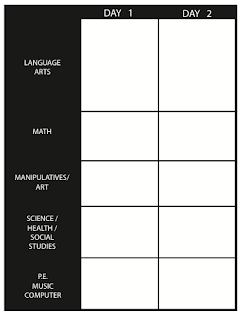Mother's offering mother's support on homeschooling, lessons plans, re-teach, kindergarten, 1st grade and 2nd grade. For all types of learners!
Tuesday, August 20, 2013
Tuesday, August 6, 2013
National American Indian Heritage Month
National American Indian Heritage Month
Native American Folk Tales
Crafts
How to make a Dream Catcher
Shields
Coloring Pages
Totems
Thursday, June 13, 2013
Wednesday, June 12, 2013
Animal Kingdom
Wednesday, June 5, 2013
HOMESCHOOLING PORTAFOLIO
- I like to record how much time my son spends on each subject. Why? Because there are days where we won't cover a subject, or others where we get excited and do two hours project or a field trip.
Some teachers only follow the structure of the book. Others, change it up each year.
For example, in science.
Plants, Living and Non-Living Things, Mammals, Vertebrates and Invertebrates.
Templates
Friday, May 31, 2013
DAILY LANGUAGE PRACTICE
Every day I provide my son with a couple 2-4 sentences and I ask him to correct them.
You can do this in your homeschooling notebook, with chalk on the floor, or on a board.
Here are a few examples,
Amy haz many stickers. (has)
She keps them in a big book. (keeps)
The stickers ar very pretty. (are)
Max the chalk uses. (uses the chalk.)
He a dog draws. (draws a dog.)
The dog is beig. (big)
jake has a new book. (Jake)
It IS about birds (is, .)
WHAT IS A SENTENCE?
A sentence is a group of words that tells acomplete thought. It begins with a capital letter and ends with a punctuation mark (.?!).
I like to use Vachel Lindsay "The Little Turtle" poem.
THE LITTLE TURTLE by Vachel Lindsay
There was a little turtle.
He lived in a box.
He swam in a puddle.
He climed on the rocks.
He snapped at a mosquito.
He snapped at a flea,
He snapped at a minnow.
And he snapped at me.
He caught the mosquito,
He caught the flea,
He caught the minnow.
But he didn't catch me.
ACTIVITIES
WORD-ORDER FUN
Materials: sentence strips, constuction paper, or flash cards.
1. Write the words of "THE LITTLE TURTLE" or any other poem, one word per piece.
2. Provide your child with words.
3.Ask child to reconstruct the poem by putting the words in order. Then have him/her read poem aloud.
Friday, May 24, 2013
Thursday, May 23, 2013
Learning the alphabet
Wednesday, May 22, 2013
Reading programs 101
Reading from Mcmillan
BIG BLUE BEES
Enjoy!
Tuesday, May 7, 2013
Tourette's Taking it to the teachers
Here is the link
And out of the blue
-How long before things get bad? As of now his tics are:, blinking, robotic fingers and coughing. So, I am wondering if there is any way of leaving it there, like stopping its progression.
- I am comforted by the idea he will outgrow it in his late teens. Now I'm just wondering when that will be and if he will. I know, I must take it a day at a time.
-I would like to know the difference between my son and the T.S. When is it him, when is it the T.S? I am aware the line will be foggy at times. I just need some sort of distinction.
Tuesday, April 23, 2013
THE SCIENTIFIC METHOD
Objectives: to analyze the scientific method
BIG QUESTIONS?
What is inquiry?
What science tools do we use?
How do scientist work?
Scientist are those who study the world around them. They do this by inquiring. INQUIRY means asking questions and looking for answers. Scientist inquier about everything, from the plants to the moon. You are a scientist too?
The first thing a scientist does is ask a question. Scientist observe by using their senses. Sometimes scientist can use what they observe to predict what will happen. Then, they try to discover the answer. Scientist will do this as they classify, compare and contrast. Scientist will also use many different tools. A tool is something that is used to do work. Some tools scientist use are: thermometer, a meterstick, safety goggles, ruler, a pan balance and a measuring cup. As scientist try to find the answer they record the steps they take to answer questions. Scientist reach a conclusion. A conclusion is what you decide after you think about all that you have learned. Once scientist find the answer they share what they learn.
+10.20.41.png)
+10.29.35.png)
+10.26.57.png)
+13.02.52.png)

+13.07.36.png)
+13.11.01.png)
+13.04.28.png)
+13.12.53.png)
+13.15.37.png)






























